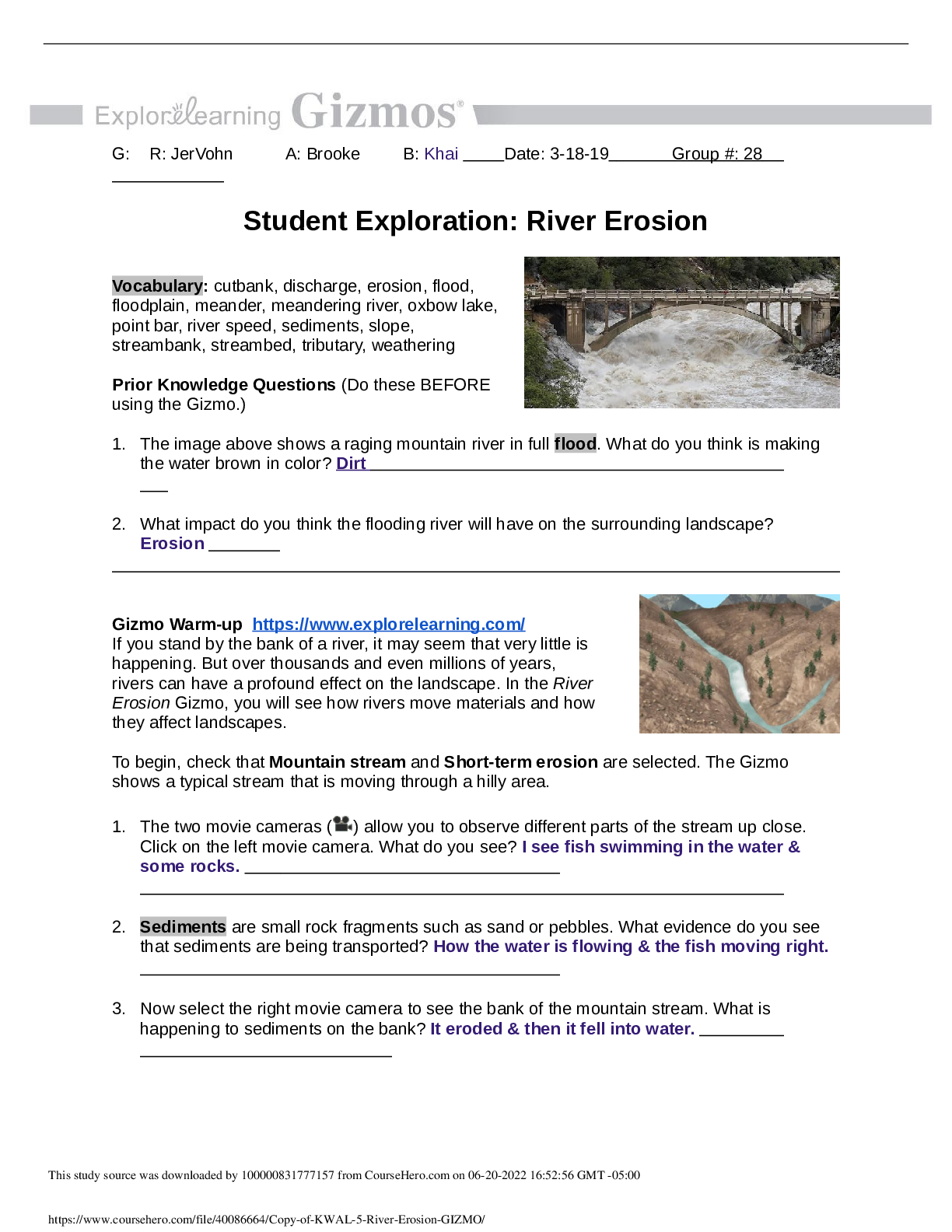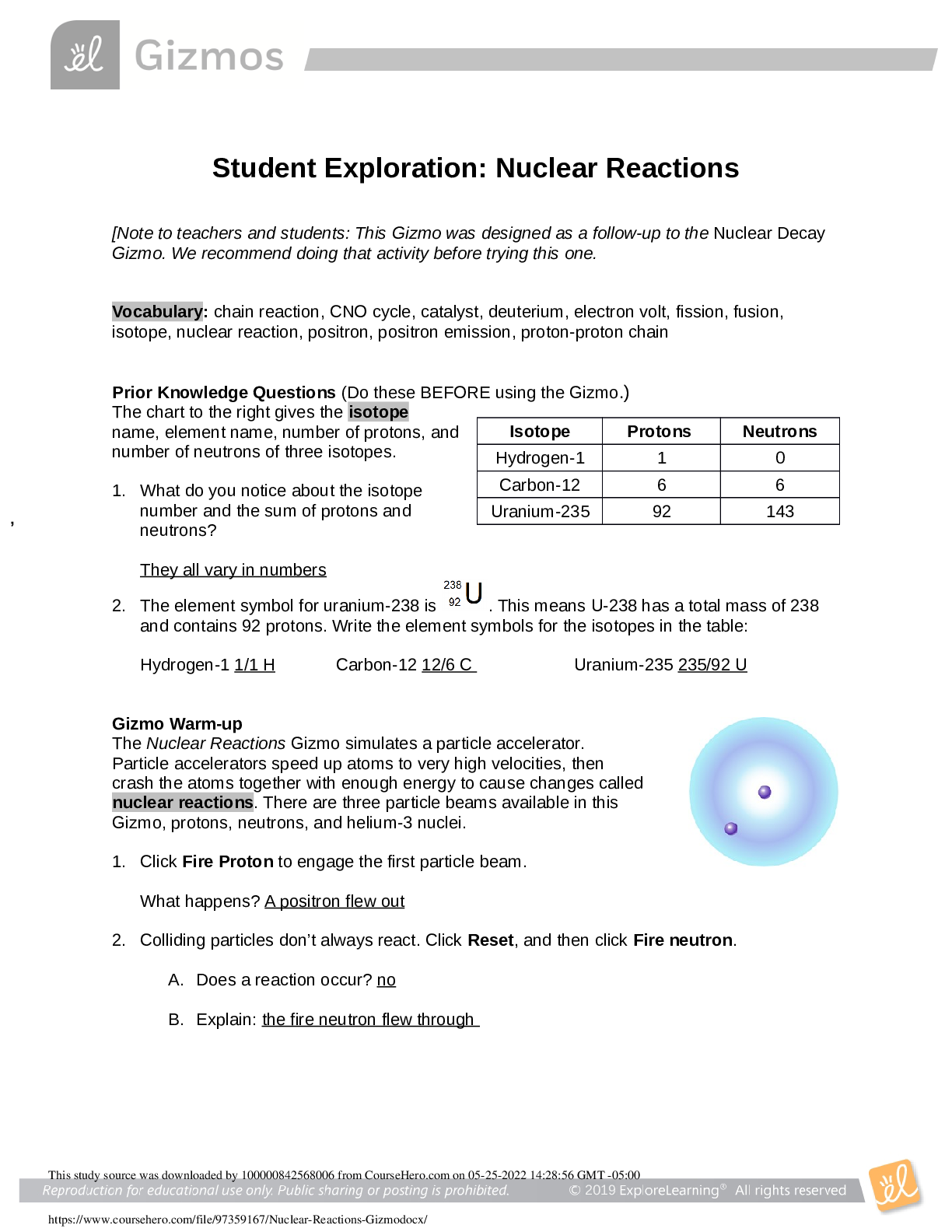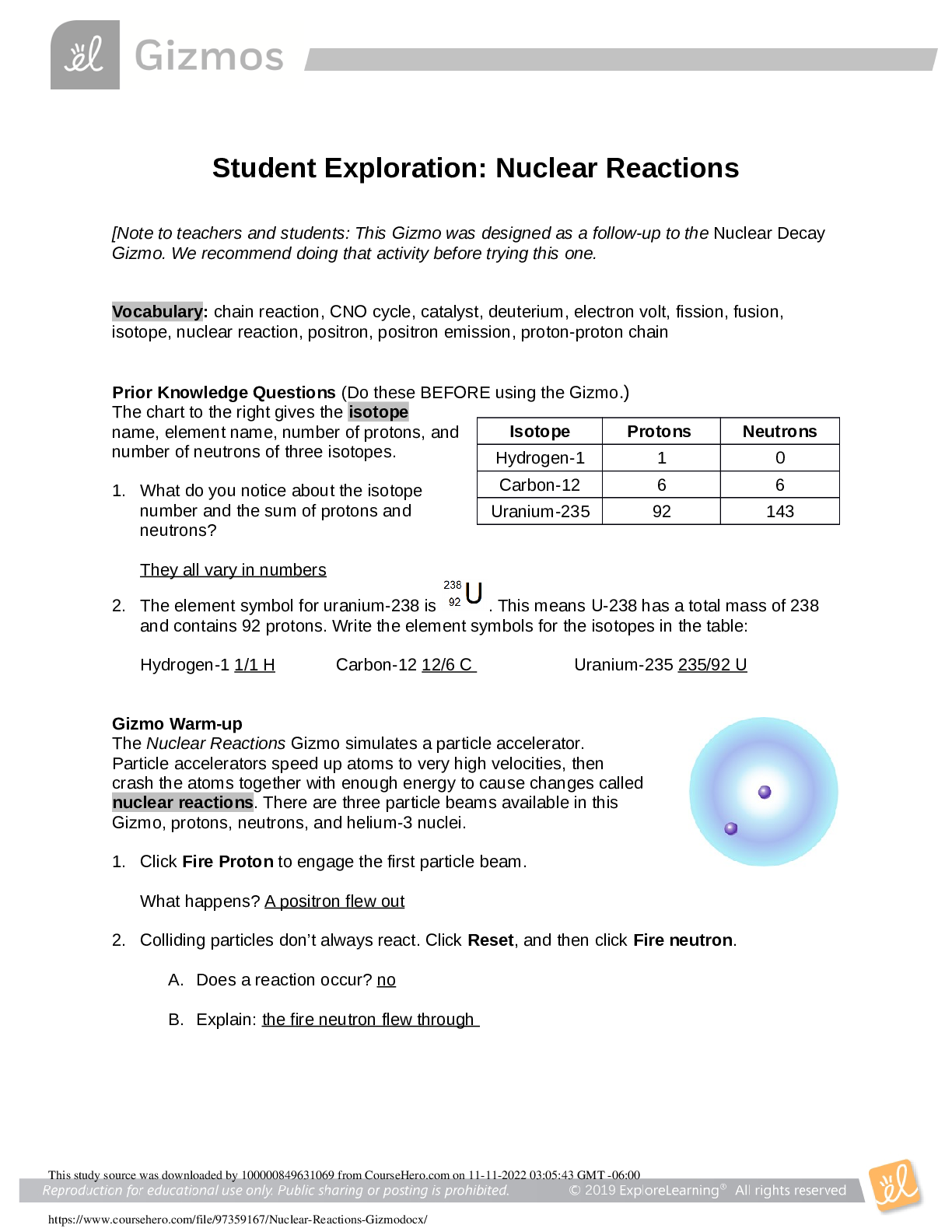Health Care > GIZMOS > Gizmos Student Exploration| Nuclear Reactions Answer Key [100% correct] (All)
Gizmos Student Exploration| Nuclear Reactions Answer Key [100% correct]
Document Content and Description Below
Gizmos Student Exploration| Nuclear Reactions Answer Key [100% correct] 2022 Student Exploration: Nuclear Reactions [Note to teachers and students: This Gizmo was designed as a follow-up to ... the Nuclear Decay Gizmo. We recommend doing that activity before trying this one. Vocabulary: chain reaction, CNO cycle, catalyst, deuterium, electron volt, fission, fusion, isotope, nuclear reaction, positron, positron emission, proton-proton chain Prior Knowledge Questions (Do these BEFORE using the Gizmo.) The chart to the right gives the isotope name, element name, number of protons, and number of neutrons of three isotopes. 1. What do you notice about the isotope number and the sum of protons and neutrons? They all vary in numbers 2. The element symbol for uranium-238 is . This means U-238 has a total mass of 238 and contains 92 protons. Write the element symbols for the isotopes in the table: Hydrogen-1 1/1 H Carbon-12 12/6 C Uranium-235 235/92 U Gizmo Warm-up The Nuclear Reactions Gizmo simulates a particle accelerator. Particle accelerators speed up atoms to very high velocities, then crash the atoms together with enough energy to cause changes called nuclear reactions. There are three particle beams available in this Gizmo, protons, neutrons, and helium-3 nuclei. 1. Click Fire Proton to engage the first particle beam. What happens? A positron flew out 2. Colliding particles don’t always react. Click Reset, and then click Fire neutron. A. Does a reaction occur? no B. Explain: the fire neutron flew through Activity A: Proton-proton chain Get the Gizmo ready: • Click Reset. • Be sure Proton-proton is selected in the Reaction menu. Introduction: All stars turn hydrogen into helium in a process called nuclear fusion. Stars perform this process in different ways. In stars like our sun, the proton-proton chain is used. This reaction requires temperatures greater than 4,000,000 K to occur. Question: How does the process of fusion turn hydrogen into helium in stars? 1. Observe: Click Fire proton and observe. What happens after the proton merges into the nucleus? A gamma is released This is a form of nuclear decay called positron emission. During positron emission, a proton decays into a neutron. In this process, it emits a positron, which is a nearly massless antimatter particle with a positive charge. 2. Observe: Click Reset and click Fire proton. Observe what happens. Many subatomic particles appear frequently in nuclear reactions. Their element symbols are given below: Neutron Positron Electron Proton (Neutrinos are also produced but are beyond the scope of this Gizmo.) Click Reset and click Fire proton. Turn on the Write equation checkbox. Based on what you have observed, write in the equation for this reaction in the Gizmo and below. 1/0 n to 0/1 e+ plus 1/1 H A. Turn on Show equation. Was your predicted equation correct? yes Correct your equation if necessary. The resulting H-2 isotope is called deuterium. B. Emitted energy is reported in megaelectron volts (MeV), where one MeV is equal to one million electron volts. How much energy is emitted in this reaction? 1.44 MeV (Activity A continued on next page) Activity A (continued from previous page) 3. Hypothesize: Click Next. In the next step, another proton will be fired at the hydrogen-2 atom. Make a prediction about what will happen by filling in the equation in the Gizmo and below, and then click Fire proton. 1/1 H to 3/2 He A. Turn on Show equation. Was your predicted equation correct? yes B. Correct your equation if necessary. How much energy was emitted? 5.48 MeV 4. Apply: Click Next. The last step in this cycle involves two helium-3 atoms reacting. Click Fire He-3. Observe what happens, and then write an equation to describe this process. 3/2 He to 4/2 he plus 1/1 H plus 1/1 H A. Turn on Show equation. Was your predicted equation correct? Yes B. Correct your equation if necessary. How much energy was emitted? 12/86 MeV 5. Calculate: To find the total energy emitted in the proton-proton chain, you have to consider the fact that two He-3 atoms must be created to form the final He-4 atom. Write the energy produced in each step, and then find the sum of all of these energies using the table below. First step (H-2 created) Second step (He-3 created) Last step (He-4 created) Total energy First He-3 atom 1.44 5.49 12.86 26.72 Second He-3 atom 1.44 5.49 6. Extend your thinking: To determine the net equation for the conversion of hydrogen-1 to helium-4, list the equations for each step of the proton-proton chain in the space at right. (Write two equations for the first step and the second step, because these are repeated.) Next, cross out any elements that appear on both sides of the equation. Anything that remains makes up the net equation. Activity B: CNO Cycle Get the Gizmo ready: • In the Reaction menu, select CNO cycle. • Select the Write equation checkbox. Introduction: In stars larger than the Sun, the CNO cycle is the main pathway for fusion. In this reaction cycle, a heavy atom like carbon or oxygen participates in each step. At the end of one cycle, the original heavy atom has been recreated and hydrogen has been transformed into helium. This reaction begins when temperatures reach 15,000,000 K or more. Question: How do large stars form helium from hydrogen through fusion? 1. Observe: The Gizmo starts with an atom of carbon that reacts with the first hydrogen atom, and produces only one product. Click Fire proton to see what happens. A. What did you see? It released a gamma B. Turn on Write equation. In the space below and in the Gizmo, write a balanced equation for this reaction. Then, turn on Show equation to check your work. 1/1 H to 13/7 n 2. Predict: Click Reset. Go through the steps of the CNO cycle. Before each step, make a prediction about what the reaction will be, and type it into the Gizmo. You can use the information in the Gizmo to help you. As you check your answers in the Gizmo, write down the correct reaction below. Record the energy emitted in each step as well. Step Equation Energy emitted 1 1/1 H to 13/7 N 1.95 MeV 2 13/6 C plus 0/1 e 2/20 MeV 3 1/1 H to 14/7 N 7.54 MeV 4 1/1 H to 15/8 O 7.35 MeV 5 15/7 N plus 0/1 e 2.73 MeV 6 1/1 H to 12/6 C plus 4/2 He 4.96 MeV (Activity B continued on next page) Activity B (continued from previous page) 3. Calculate: What is the total energy emitted by the CNO cycle? 26.73 How does this value compare to the energy released in the proton-proton chain? same [Show More]
Last updated: 2 years ago
Preview 1 out of 8 pages

Buy this document to get the full access instantly
Instant Download Access after purchase
Buy NowInstant download
We Accept:

Reviews( 0 )
$11.00
Can't find what you want? Try our AI powered Search
Document information
Connected school, study & course
About the document
Uploaded On
Jan 11, 2023
Number of pages
8
Written in
Additional information
This document has been written for:
Uploaded
Jan 11, 2023
Downloads
0
Views
100







